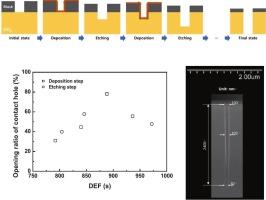使用具有低全球变暖潜势的七氟丙基甲基醚循环蚀刻SiO2接触孔
IF 7.9
2区 材料科学
Q1 MATERIALS SCIENCE, MULTIDISCIPLINARY
引用次数: 0
摘要
采用七氟丙基甲基醚(HFE-347mcc3)循环刻蚀工艺刻蚀具有高长径比的SiO2接触孔,与传统的全氟碳化合物(pfc)和氢氟碳化合物(hfc)相比,其全球变暖潜势(GWP≈530)较低。在循环过程中,HFE-347mcc3/O2/Ar等离子体的蚀刻步骤与HFE-347mcc3/Ar等离子体的沉积步骤交替进行,以精确控制侧壁的氟碳钝化膜。系统地研究了沉积和蚀刻步骤时间对接触孔轮廓的影响。增加沉积阶段的持续时间最初改善了侧壁保护,从而显著减少了弯曲,增强了各向异性;然而,过长的沉积步骤持续时间导致狭窄。同样,蚀刻步骤的持续时间进行了优化,以实现足够的氟碳膜硬化,以防止弯曲,同时避免过度变窄。引入氟碳等离子体暴露度作为优化各向异性的关键参数。在优化条件下,成功获得了直径为100 nm、纵横比为24、弯曲最小(1 nm)的近垂直、高各向异性SiO2接触孔。结果表明,HFE-347mcc3是一种可行且环境可持续的高gwp pfc或hfc替代品,具有环境效益和优异的蚀刻性能。本文章由计算机程序翻译,如有差异,请以英文原文为准。

Cyclic etching of SiO2 contact holes using heptafluoropropyl methyl ether having low global-warming potential
SiO2 contact holes having high aspect ratios were etched using a cyclic-etching process employing heptafluoropropyl methyl ether (HFE-347mcc3) which exhibits a low global-warming potential (GWP ≈530) compared with conventional perfluorocarbons (PFCs) and hydrofluorocarbons (HFCs). In this cyclic process, the etching steps involving HFE-347mcc3/O2/Ar plasmas were alternated with deposition steps involving HFE-347mcc3/Ar plasmas to precisely control the fluorocarbon passivation films on the sidewalls. The effects of the deposition- and etching-step durations on the contact-hole profiles were systematically investigated. Increasing the duration of the deposition step initially improved sidewall protection, thereby significantly reducing bowing and enhancing anisotropy; however, excessively long deposition-step durations caused narrowing. Similarly, the duration of the etching step was optimized to achieve sufficient fluorocarbon-film hardening to prevent bowing while avoiding excessive narrowing. The degree of exposure to fluorocarbon plasma was introduced as a critical parameter to optimize the anisotropy. Under optimized conditions, a nearly vertical and highly anisotropic SiO2 contact hole having a diameter of 100 nm and an aspect ratio of 24 was successfully obtained with minimal bowing (1 nm). The results revealed that HFE-347mcc3 is a viable and environmentally sustainable alternative to high-GWP PFCs or HFCs and provide both environmental benefits and excellent etching performance.
求助全文
通过发布文献求助,成功后即可免费获取论文全文。
去求助
来源期刊

Materials & Design
Engineering-Mechanical Engineering
CiteScore
14.30
自引率
7.10%
发文量
1028
审稿时长
85 days
期刊介绍:
Materials and Design is a multi-disciplinary journal that publishes original research reports, review articles, and express communications. The journal focuses on studying the structure and properties of inorganic and organic materials, advancements in synthesis, processing, characterization, and testing, the design of materials and engineering systems, and their applications in technology. It aims to bring together various aspects of materials science, engineering, physics, and chemistry.
The journal explores themes ranging from materials to design and aims to reveal the connections between natural and artificial materials, as well as experiment and modeling. Manuscripts submitted to Materials and Design should contain elements of discovery and surprise, as they often contribute new insights into the architecture and function of matter.
 求助内容:
求助内容: 应助结果提醒方式:
应助结果提醒方式:


